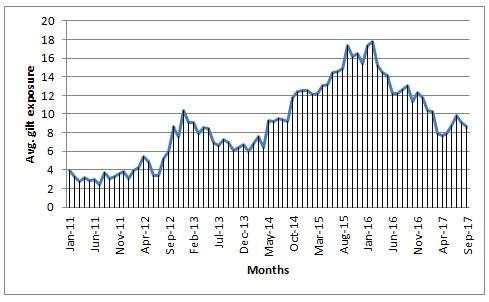If you thought only dynamic bond funds adjusted their portfolios to rate cycles, a look at balanced fund portfolios may throw a surprise. Traditionally, balanced funds don’t juggle their debt component too much, preferring to simply hold top-rated corporate debt.
That changed post 2014, when several balanced funds began to take a call on interest rates to gain from bond price rallies. The most effective way to play duration and make money off falling rates is to invest in government securities. The average exposure to gilts for balanced funds began inching higher from 2013 onwards. As a result, balanced funds that took such duration calls gained on both the equity and debt fronts. In the rally that kicked off in 2014, the equity portion of the portfolio received a boost from the price rallies on the debt portion of the portfolio as well.
Rising gilt exposure
Balanced funds on an average keep about 70% of their portfolio in equities and the remaining 30% in debt. This debt is usually in the form of medium to long-term AAA-rated bonds of public sector institutions, private companies, and banks. Funds follow an accrual strategy, holding the bonds and earning interest accrued.
In earlier rate cut cycles, such as that in 2012, balanced funds have not been aggressive in their debt portfolios. Average gilt exposure hovered between 5% and 8% for the most part. From mid-2014 onwards, however, when gilts first rallied, the average exposure began to rise quickly. In 2015, gilts accounted for more than half or more the debt portfolio, indicating that funds were getting increasingly aggressive on the debt front as well. With the rate cut cycle now appearing to be drawing to a close, funds have brought down their gilt exposures. Even so, it remains much higher than previous years.
 That means fund returns are subject not just to equity market volatility, but debt markets too. Earlier, the focus was on dynamically managing the equity side of the portfolio, with the debt simply there to provide stability. If the trend of dynamically managing the debt side to boost returns continues, it could mean higher volatility for balanced funds albeit for potentially higher returns. Fund manager ability to call rate cycles correctly would also come into play.
That means fund returns are subject not just to equity market volatility, but debt markets too. Earlier, the focus was on dynamically managing the equity side of the portfolio, with the debt simply there to provide stability. If the trend of dynamically managing the debt side to boost returns continues, it could mean higher volatility for balanced funds albeit for potentially higher returns. Fund manager ability to call rate cycles correctly would also come into play.







